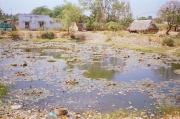Water Quality
| Environmental Science | |
|---|---|
| Topics | What is the Environment | Population | Ecological Footprint, Food, and Urbanization | Ecology - Definitions and Outline | Energy Flow in Ecosystems | Population and Community Ecology | Biogeochemical Cycles | Biodiversity | Energy | Atmosphere and Climate | Global Warming | Air Quality | Water Quantity | Water Quality | Solid Waste |
| Survey types of water pollution
(note: for discussion of water quantity and supply see the previous section) |
Contents
Introduction
Safe drinking water and sanitation are two of the most important indicators of quality of life. They make up Goal 6 of the Sustainable Development Goals.
- Water scarcity affects 40% of the world's population.
- 1.8 billion people use a contanimated drinking water source.
- About one-third of the World's population (2.4 billion) have improper sanitation.
- 80% of all wastewater is discharged without treatment.
- Every day, 1000 children die of diarrheal diseases
Diseases related to contamination of drinking-water constitute a major burden on human health. Interventions to improve the quality of drinking-water provide significant benefits to health.
- World Health Organization
Water Pollution

Types of water pollution
- dissolved organic matter
- pathogen
- nutrients
- sediments
- heat
- toxic chemicals
Two types of water pollution sources:
- Point sources: pollution is from a specific location
- Examples: pipe, sewer, oil well
- Nonpoint sources: not from any single site
- Examples: agricultural runoff, oil from city streets
- Nonpoint sources are very difficult to control
Pathogens
The source of pathogens is human and animal wastes. They can cause some very serious diseases, such as cholera.
Coliform
Coliforms are only naturally found in the gut of animals (including humans).
High numbers of coliform in water, therefore indictates contamination by animal or human waste and possible presence of pathogens. This is a commonly used test of water pollution.
Dissolved organic matter
This includes manure and plant debris. Human sources include sewage, runoff from feedlots, and paper mills.
When microorganisms breakdown this organic matter it removes dissolved oxygen from the water. This dissolved oxygen is necessary for fish and other aquatic organisms to survive.
BOD
The measure of the amount of oxygen-demanding wastes is the Biological Oxygen Demand (BOD). It is the amount of dissolved oxygen needed by aerobic decomposers to break down organic matter at 20 degrees Celsius in 5 days.
Nutrients
Ironically, nutrients - especially nitrates and phosphates - can cause water pollution.
Sources: sewage, agricultural runoff from fertilizers, detergents (these contain phosphorus).
Excess nutrients can cause a condition called eutrophication.
Eutrophication
Excess nutrients cause algae and other aquatic plants to grow. When these die, decomposers feed on them deplete the dissolved oxygen. This can kill fish and other aquatic organisms.
Sediments
Fine particles can become suspended in the water column. The main source is soil erosion.
They can have a number of effects:
- reduce photosynthesis
- carry bacteria, toxic chemicals, and nutrients
- settle on the bottom covering fauna
- fill lakes and reservoirs
Thermal pollution
Water used to cool power plants and other industries is often released to rivers or lakes.
This hot water changes the water temperature. This in turn lowers dissolved oxygen and disrupts the normal activity of aquatic organisms.
It also increases evaporation.
Toxic chemicals
Many chemicals are toxic: lead, arsenic, pesticides, oil, etc.
Sources: surface runoff, industrial effluents, seepage from landfills.
Toxic chemicals can cause a variety of health effects. They can also harm fish and wildlife.
| Read the following articles:
Sanitation Too Often Overlooked in Developing Nations Then answer the following questions:
|
